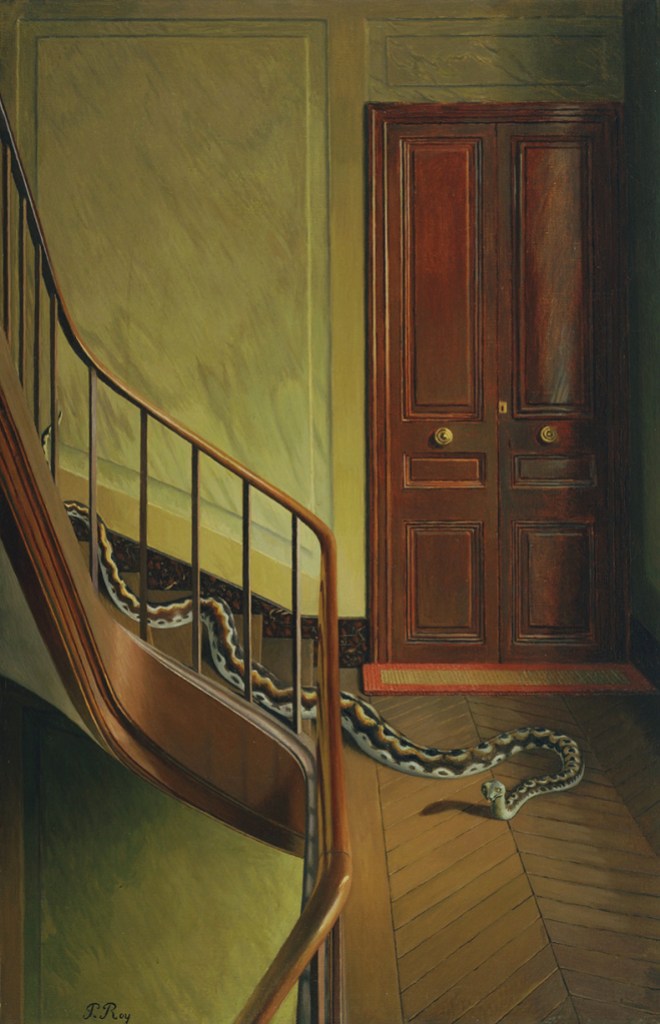From the March 2024 issue of Apollo. Preview and subscribe here.
Pierre Roy caused barely a ripple in the Surrealist movement. He was nominally a member of the group from 1925 to 1928, participated in some of its early art exhibitions and frequented its cafe klatches. But André Breton does not mention him in his seminal round-up of Surrealist artists, Surrealism and Painting (1928), written concurrently with Roy’s involvement in the movement, and Roy’s signature does not appear on any collective statements. His departure was as unheralded as his arrival. The main dictionaries and histories of Surrealism largely ignore him; surveys of its art leave him out. And yet, his canvas Danger on the Stairs, from 1927 or 1928, is arguably the most Surrealist painting to be produced during the movement’s early heyday, before Dalí’s melted watches and Oppenheim’s fur-covered cup defined what Surrealist art ‘should’ look like.
Born in 1880, Roy was nearly two decades older than the twenty-somethings who formed the initial Surrealist group. He had begun painting under the influence of Fauvism, but later, perhaps swayed by Giorgio de Chirico, he switched to producing canvases featuring odd collocations of disparate objects, the best of which generate the kind of disorienting mystery that Breton identified as the province of Surrealist art – art that externalises ‘a purely internal model’ and visualises that ‘which is not visible’.
Danger on the Stairs both epitomises and subtly shifts Breton’s framing. The scene is of a banal staircase in a disturbingly ordinary Paris apartment building. A door, a railing, a jute mat, soporific faux-marble walls. You can anticipate the muffled creak of the photorealistic floorboards. All is eerily quiet, except that down the stairs slithers a diamondback snake, staring at the viewer as if lying in wait for the next unsuspecting soul to emerge from the floor below.

Danger on the Stairs (1927/1928), Pierre Roy. Museum of Modern Art, New York
Freud applied the term ‘uncanny’ to those moments when our irrational dreads collide with our rationally conditioned dismissals of them in ways that we can’t immediately resolve and are forced to experience viscerally. More than any other of Roy’s canvases – and more than most works produced by the higher-profile figures to tromp through Surrealism – Danger on the Stairs confronts us with that state of unreality and unbelief, the collision of elements that by rights should never come into contact, and to which we’re given no time to react before the danger strikes.
But where Thanatos creeps, Eros rarely lags behind. Surrealist expressions of the uncanny combine the quotidian with the unexpected, inexplicable and disorienting, but also the oddly pleasurable. Breton described such moments as eliciting ‘a physical sensation […] like the feeling of a feathery wind brushing across my temples to produce a real shiver’. That shiver might result from looking at a work of art, just as much as from a chance encounter, a startling coincidence or the juxtaposition of two irreconcilable realities – in the case of Roy’s painting, the two realities being just close enough, just reconcilable enough, that their superimposition carries not only the thrill of novelty but also the shock of hazard.
This is different from most standard reactions to Surrealist art, the kind that greeted works such as Dalí’s William Tell (which sent the English writer Norman Douglas rushing from the room for fear it would ‘spoil his dinner’) or Man Ray’s The Gift, a flatiron with a row of tacks glued down the middle (‘But you’ll ruin the shirt if you put tacks on there!’ the salesman protested). Danger on the Stairs is less in-your-face. It sneaks up on you, like its reptile protagonist; your eye first goes to the door that dominates much of the visual space, as you would approach that door when paying a visit. Only then do you notice the incongruous and deadly foreign element, and the effect is all the more chilling because of it – feathery wind, indeed.
Roy’s tenure among the Surrealists coincided with the movement’s severe growing pains, public and private. In 1927–28, Breton, who exercised over the group an authority that was virtually erotic in its intensity, was undergoing a personal crisis because of a calamitous love affair and the resulting marital strife. The tensions were often vented on those around him, causing more than one nervous breakdown – Breton was a masterful and merciless prosecutor – and culminating the following year in a vast purge of group members and the no-holds-barred vitriol of the Second Manifesto. The entrance to Breton’s apartment at 42 rue Fontaine was not unlike the one in the painting, and chances are that Roy saw it many times during his Surrealist sojourn. We can only wonder whether the trepidatious climber whose viewpoint we’re adopting is the painter himself, the danger not so much the serpent on the stairs as the venom lurking behind the door.
From the March 2024 issue of Apollo. Preview and subscribe here.
Unlimited access from just $16 every 3 months
Subscribe to get unlimited and exclusive access to the top art stories, interviews and exhibition reviews.














![Masterpiece [Re]discovery 2022. Photo: Ben Fisher Photography, courtesy of Masterpiece London](http://zephr.apollo-magazine.com/wp-content/uploads/2022/07/MPL2022_4263.jpg)
The threat to Sudan’s cultural heritage